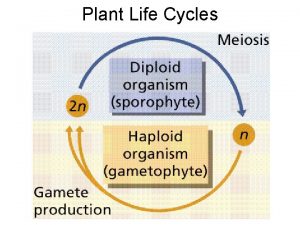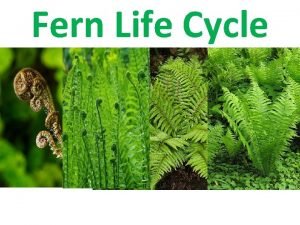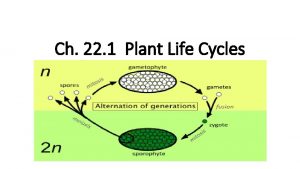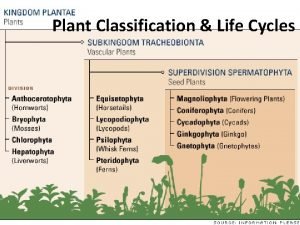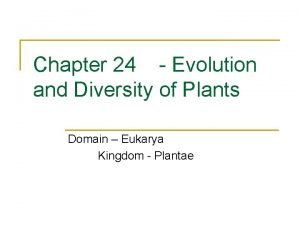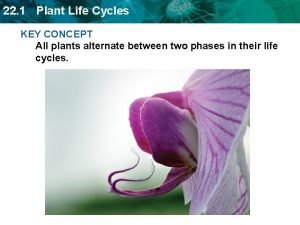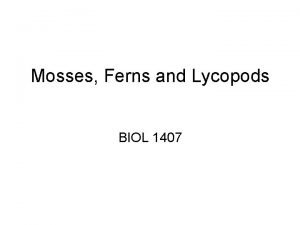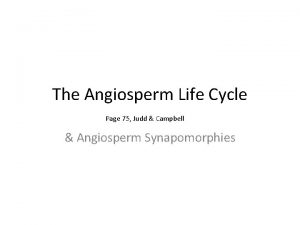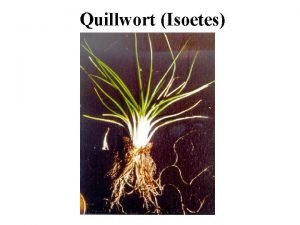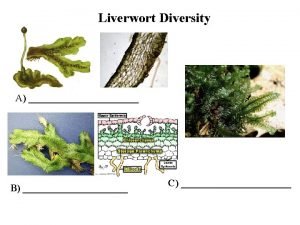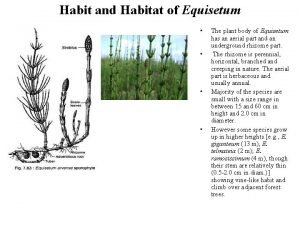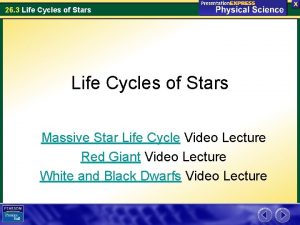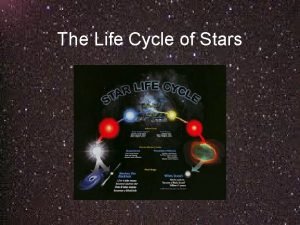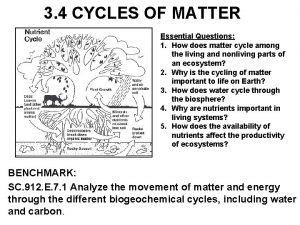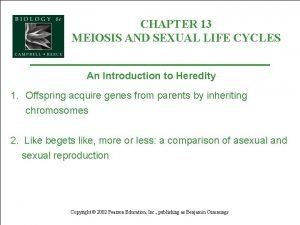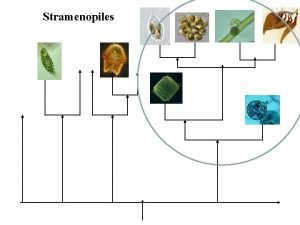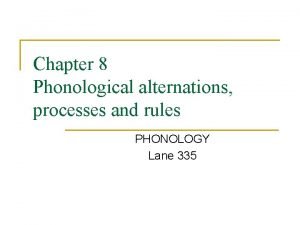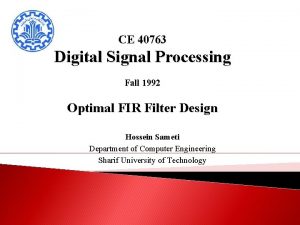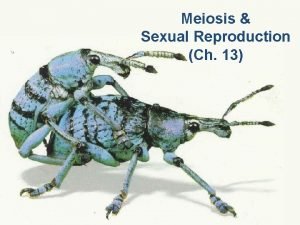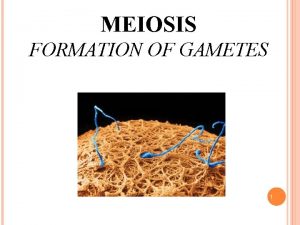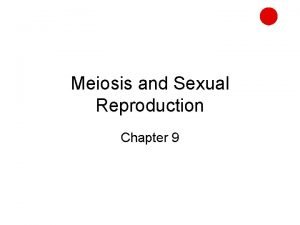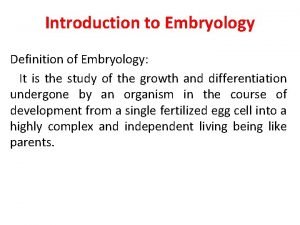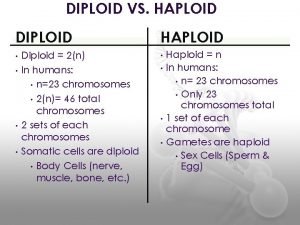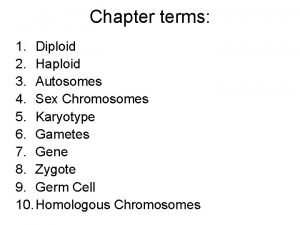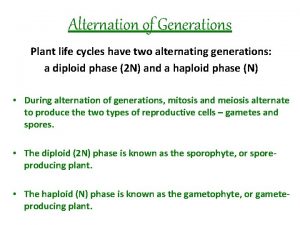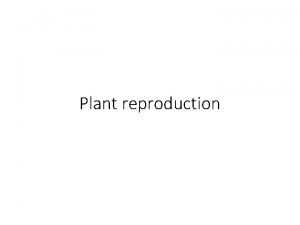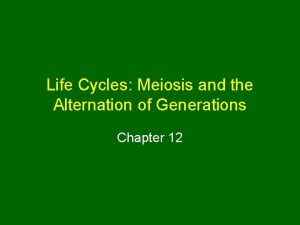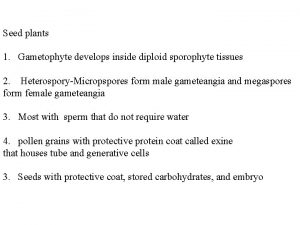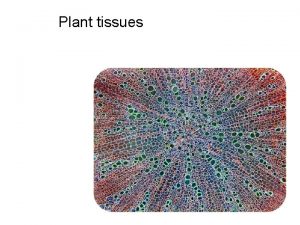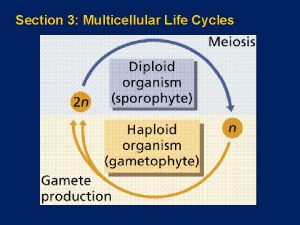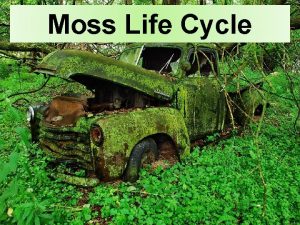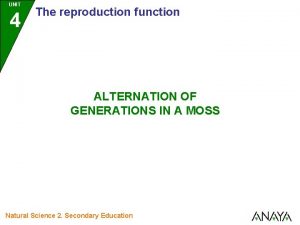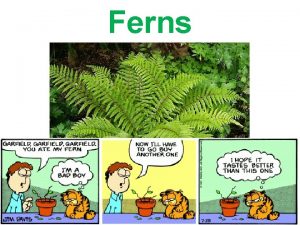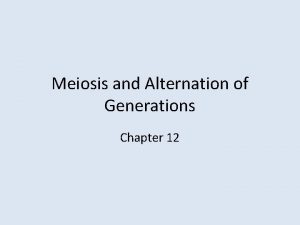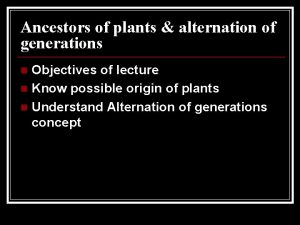Plant Life Cycles Alternation of generations Sporophyte diploid












































- Slides: 44

Plant Life Cycles

Alternation of generations • Sporophyte (diploid) – Begins when sperm fertilizes egg (zygote) – Diploid zygote divides by mitosis to create a mature sporophyte – Meiosis produces haploid cells called spores – Haploid spores released

Alternation of generations • Gametophyte (haploid) – Begins with spores created by meiosis – Spore grows into gametophyte • Male gametophyte creates sperms • Female gametophyte creates eggs – Sperm & egg create diploid zygote (process repeats)

Mosses • Nonvascular, seedless • Grow low to ground to retain moisture • Lack true leaves – Leaf-like structures only 1 cell thick • Rhizoids anchor into soil • Early inhabitant of new ecosystems (succession)

• Gametophyte phase – Dominant stage – Carpet of moss growing near ground Moss Life Cycle • Archegonium: produces female egg • Antheridium: produces male sperm – Sperm swims through water to fertilize egg • Sporophyte phase – Stalk grows up from the gametophyte – Sporangia houses haploid spores – Spores land new gametophyte grows See appendix B in your text book

1) Moss gametophytes grow near the ground (haploid stage) 2) Through water, sperm from the male gametophyte will swim to the female gametophyte to create a diploid zygote 3) Diploid sporophyte will grow from the gametophyte where the zygote is located . . . sporophyte gametophyte 4) Sporophyte will create and release haploid spores

5) Spores land grow into new gametophytes 6) The process repeats gametophyte ground


Ferns • Seedless, vascular plants – Vascular: allows taller growth • Rhizoids: underground stems draw nutrients • Fronds: leaves uncurl – sporangia on underside • Sori: clusters of sporangia

Fern Life Cycle • Sporophyte phase – Dominant stage – Sporangia produces haploid spores – Spores released into air • Gametophyte phase – Spore grows into prothallus • Archegonium: produces female egg • Antheridium: produces male sperm See appendix B in your text book – Sperm swims to egg – Zygote begins sporophyte stage

1) Sporophyte creates and releases haploid spores . . Adult Sporophyte (diploid) ground

2) Spores land in the soil ground

3) From the haploid spores, a prothallus (haploid gametophyte) grows in the soil -- Rhizoids anchor Let’s zoom in ground

4) Sperm swim through water from the antheridium to the archegonia Let’s zoom back out

5) Diploid sporophyte (fiddlehead) grows from the prothallus -- prothallus eventually dies ground

6) Fiddlehead uncurls into fronds of ferns. 7) Cycle repeats -- Sporangia creates spores to be released . . . ground .


Conifers • Seed advantages – Don’t depend on water – Protects & nourishes embryo – Allow plants to grow in new locations • Conifers: woody cone houses seeds – Male cones: produce pollen – Female cones: produce egg • Pines, redwoods, spruce, cedar

Conifer Life Cycle • Sporophyte phase (dominant) – Cones grow on tree – Female cones • Megaspores inside archegonia (gametophyte) – Male cones • Microspores (gametophyte) released from antheridia • sticks to archegonium • Pollen tube grows from pollen • Sperm travels down pollen tube (zygote/seed created) • Sporophyte stage restarts

1) Male and female seed cones grow in adult sporophytes

2) Pollen grains released from the male seed cones -- Pollen is the male gametophyte Let’s zoom into the female seed cone

3) Pollen grain sticks to the female ovule 4) Pollen tube grows from the male spore 5) Two nuclei transfer into female spore - one fertilizes the egg 6) Diploid embryo develops (sporophyte stage restarts)

7) After seeds harden, the cone reopens and the seeds are released

8) Seed will land ground

9) Seedling grows into (sporophyte)…the cycle repeats ground

female

Flowers • Reproductive structure of flowering plants • Sepals – outer ring of leaves – protection • Petals – Inner ring of leaves – Brightly colored to attract pollinators • Open petals & sepals reveal male and female structures

Flowers • Female Carpal – Inner most part – Ovary: within the base (female gametophyte) – Style: long stalk – Stigma: sticky tip, collects pollen • Male Stamen – Surrounds carpal – Filaments: long stalks – Anther: produces pollen (male gametophyte)

• 1) Flower matures and opens

• 2) Microspores (male gametophytes) created in the anthers

In the Anthers • Meiosis makes 4 microspores • In each microspore – Nucleus splits in two – 1 nucleus: forms pollen tube – 1 nucleus: splits again to make 2 more nuclei • 1 nucleus: fertilizes the egg • 1 nucleus: fuses to make endosperm

• 3) Microspores continue to develop

• 4) Ovaries divide by meiosis to create megaspore

In the Ovules • Meiosis makes 4 megaspores (only 1 survives) • In megaspore – Mitosis creates 8 nuclei – 1 nucleus: egg cell – 2 nuclei: form embryo sac – 5 nuclei: disintegrate

Microspore lands on stigma

Microspores (pollen) released

Microspores (pollen) land on the stigma

Pollen tube and 2 nuclei transfer into the ovule . .

• 5 & 6) Pollen tube grows from pollen – Two sperm nuclei follow down the pollen tube

• 7) Double fertilization: – 1 sperm nuclei fuses w/ egg (zygote created) – 1 sperm nuclei fuses w/ the embryo sac (endosperm created)

• 8) Ovule hardens to form seed

Fruit Production • In the seed – Embryo – Endosperm • Surrounding ovary grows into a fruit • Fruit attracts animals to eat and spread the seeds Fruit seeds in fox droppings

9) Seed germinates…cycle repeats

End of the Semester!
 Plant life cycles and alternation of generations
Plant life cycles and alternation of generations Do ferns show alternation of generations
Do ferns show alternation of generations Ganetophyte
Ganetophyte Alternation of generations
Alternation of generations Alternation of generations
Alternation of generations A plant's life cycle alternates between and generations.
A plant's life cycle alternates between and generations. Is a fern sporophyte or gametophyte
Is a fern sporophyte or gametophyte Sporophyte
Sporophyte Isoetes corm
Isoetes corm Mature sporophyte
Mature sporophyte Hydrophytic and xerophytic characters of equisetum
Hydrophytic and xerophytic characters of equisetum Dichotomously branching sporophyte
Dichotomously branching sporophyte Carbon cycle poem
Carbon cycle poem Rvguev
Rvguev How many eggs do kiwis lay
How many eggs do kiwis lay Section 26.3 life cycles of stars
Section 26.3 life cycles of stars What is charted on an hr diagram
What is charted on an hr diagram Style fashion and fad life cycles
Style fashion and fad life cycles Basidiocarp life cycle
Basidiocarp life cycle Chapter 13: meiosis and sexual life cycles
Chapter 13: meiosis and sexual life cycles Cycling of matter in an ecosystem
Cycling of matter in an ecosystem Chapter 13 meiosis and sexual life cycles
Chapter 13 meiosis and sexual life cycles Ectocarpus
Ectocarpus Strict alternation
Strict alternation What is busy waiting in os
What is busy waiting in os Alpha notation phonology
Alpha notation phonology Alternation in phonology
Alternation in phonology Alternation theorem in dsp
Alternation theorem in dsp Metafora air tenang
Metafora air tenang Alternation of generation fern
Alternation of generation fern Single character alternation in regexp
Single character alternation in regexp Produces haploid cells
Produces haploid cells If a diploid egg was produced by mitosis
If a diploid egg was produced by mitosis Prophase 2
Prophase 2 Primary oocyte haploid or diploid
Primary oocyte haploid or diploid Diploid to haploid meiosis
Diploid to haploid meiosis What is meiosis
What is meiosis Metaphase
Metaphase Primary oocyte haploid or diploid
Primary oocyte haploid or diploid Meiosis stages
Meiosis stages What process occurs
What process occurs Parthenogenese
Parthenogenese Primary oocyte definition
Primary oocyte definition Diploid vs haploid number
Diploid vs haploid number Are diploid cells produced in meiosis
Are diploid cells produced in meiosis
